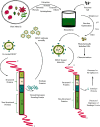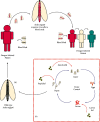Green Nano-Biotechnology: A New Sustainable Paradigm to Control Dengue Infection
- PMID: 35979184
- PMCID: PMC9377959
- DOI: 10.1155/2022/3994340
Green Nano-Biotechnology: A New Sustainable Paradigm to Control Dengue Infection
Abstract
Dengue is a growing mosquito-borne viral disease prevalent in 128 countries, while 3.9 billion people are at high risk of acquiring the infection. With no specific treatment available, the only way to mitigate the risk of dengue infection is through controlling of vector, i.e., Aedes aegypti. Nanotechnology-based prevention strategies like biopesticides with nanoformulation are now getting popular for preventing dengue fever. Metal nanoparticles (NPs) synthesized by an eco-friendly process, through extracts of medicinal plants have indicated potential anti-dengue applications. Green synthesis of metal NPs is simple, cost-effective, and devoid of hazardous wastes. The recent progress in the phyto-synthesized multifunctional metal NPs for anti-dengue applications has encouraged us to review the available literature and mechanistic aspects of the dengue control using green-synthesized NPs. Furthermore, the molecular bases of the viral inhibition through NPs and the nontarget impacts or hazards with reference to the environmental integrity are discussed in depth. Till date, major focus has been on green synthesis of silver and gold NPs, which need further extension to other innovative composite nanomaterials. Further detailed mechanistic studies are required to critically evaluate the mechanistic insights during the synthesis of the biogenic NPs. Likewise, detailed analysis of the toxicological aspects of NPs and their long-term impact in the environment should be critically assessed.
Copyright © 2022 Tanzeel Zohra et al.
Conflict of interest statement
The authors declare that they have no conflicts of interest.
Figures
Similar articles
-
Effect of mycosynthesized silver nanoparticles from filtrate of Trichoderma harzianum against larvae and pupa of dengue vector Aedes aegypti L.Environ Sci Pollut Res Int. 2014 Mar;21(6):4624-33. doi: 10.1007/s11356-013-2358-6. Epub 2013 Dec 19. Environ Sci Pollut Res Int. 2014. PMID: 24352539
-
Tackling the growing threat of dengue: Phyllanthus niruri-mediated synthesis of silver nanoparticles and their mosquitocidal properties against the dengue vector Aedes aegypti (Diptera: Culicidae).Parasitol Res. 2015 Apr;114(4):1551-62. doi: 10.1007/s00436-015-4339-9. Epub 2015 Feb 12. Parasitol Res. 2015. PMID: 25669140
-
Nanoparticles in the fight against mosquito-borne diseases: bioactivity of Bruguiera cylindrica-synthesized nanoparticles against dengue virus DEN-2 (in vitro) and its mosquito vector Aedes aegypti (Diptera: Culicidae).Parasitol Res. 2015 Dec;114(12):4349-61. doi: 10.1007/s00436-015-4676-8. Epub 2015 Aug 21. Parasitol Res. 2015. PMID: 26290219
-
Phytonanotherapy for management of diabetes using green synthesis nanoparticles.J Photochem Photobiol B. 2017 Aug;173:626-639. doi: 10.1016/j.jphotobiol.2017.06.028. Epub 2017 Jun 27. J Photochem Photobiol B. 2017. PMID: 28709077 Review.
-
Recent Developments in the Biosynthesis of Cu-Based Recyclable Nanocatalysts Using Plant Extracts and their Application in the Chemical Reactions.Chem Rec. 2019 Feb;19(2-3):601-643. doi: 10.1002/tcr.201800069. Epub 2018 Sep 19. Chem Rec. 2019. PMID: 30230690 Review.
Cited by
-
Understanding Dengue Underreporting: An Analysis of the Impacts for the World, Latin America and Brazil.ScientificWorldJournal. 2025 Jul 16;2025:9993911. doi: 10.1155/tswj/9993911. eCollection 2025. ScientificWorldJournal. 2025. PMID: 40704162 Free PMC article. Review.
-
Phytotherapeutic Approach in the Management of Cisplatin Induced Vomiting; Neurochemical Considerations in Pigeon Vomit Model.Oxid Med Cell Longev. 2022 Sep 13;2022:3914408. doi: 10.1155/2022/3914408. eCollection 2022. Oxid Med Cell Longev. 2022. PMID: 36148411 Free PMC article.
-
Biogenic Selenium Nanoparticles: Anticancer, Antimicrobial, Insecticidal Properties and Their Impact on Soybean (Glycine max L.) Seed Germination and Seedling Growth.Biology (Basel). 2023 Oct 24;12(11):1361. doi: 10.3390/biology12111361. Biology (Basel). 2023. PMID: 37997960 Free PMC article.
-
Demographic and clinical features of dengue fever infection in Pakistan: a cross-sectional epidemiological study.Trop Dis Travel Med Vaccines. 2024 Apr 5;10(1):11. doi: 10.1186/s40794-024-00221-4. Trop Dis Travel Med Vaccines. 2024. PMID: 38581059 Free PMC article.
-
Development of an Eco-Friendly Nanogel Incorporating Pectis brevipedunculata Essential Oil as a Larvicidal Agent Against Aedes aegypti.Pharmaceutics. 2024 Oct 18;16(10):1337. doi: 10.3390/pharmaceutics16101337. Pharmaceutics. 2024. PMID: 39458666 Free PMC article.
References
-
- Ayaz M., Nawaz A., Ahmad S., et al. Underlying anticancer mechanisms and synergistic combinations of phytochemicals with cancer chemotherapeutics: potential benefits and risks. Journal of Food Quality . 2022;2022:15. doi: 10.1155/2022/1189034.1189034 - DOI
-
- Mubemba B., Mburu M. M., Changula K., et al. Current knowledge of vector-borne zoonotic pathogens in Zambia: a clarion call to scaling-up “one health” research in the wake of emerging and re-emerging infectious diseases. PLoS Neglected Tropical Diseases . 2022;16(2) doi: 10.1371/journal.pntd.0010193.e0010193 - DOI - PMC - PubMed
Publication types
LinkOut - more resources
Full Text Sources




